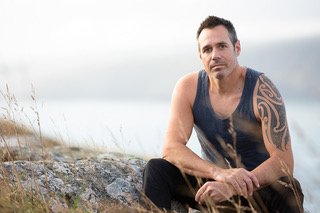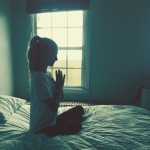
by Matt Calman, The Longest Day
I regard it as a minor miracle I became a yogi. For as long as I can remember, in the four-decade-long pre-yoga phase of my life I was horribly inflexible, and unable to get within a foot of touching my toes. My main pastimes in my 20s included playing rugby and drinking beer with my teammates. In my mind, activities such as yoga and ballet dwelt at the opposite end of the spectrum from my modus operandi.
If anyone had suggested to the younger me that I would one day become a meditating yogi, I would have laughed them out of the room. It just wasn’t on my radar, though in hindsight I realise it was exactly what I needed.
A confluence of situations in my life brought me to yoga. By late 2016, I was rehabbing an old rugby injury to my shoulder that had flared up and a dodgy back. My physiotherapist had suggested yoga could help my recovery and strengthen my weak core.
It wasn’t just my body that was feeling the strain. A month earlier, a perfect storm of stresses in my life triggered a severe, and terrifying panic attack. I was rushed to hospital in the back of an ambulance with pains in my chest, my hands and feet numb, and my breathing tight and halting. I thought I was having a heart attack.
It was just a few days since the panic attack when I met with a counsellor for the first time in my life. I also bought my first herbal remedy at a health store to calm my still-racing central-nervous-system. The store person immediately mentioned my shallow, poor breathing.
My wife Ranui had become a regular at a yoga studio near to our home in Christchurch. I had noticed how it had improved her general wellbeing and especially how it had eased her tension and stress. I decided to take a class with her to see if yoga could help me too.
I still have a vivid memory of my first class, and if I could sum it up in two words they would be; extreme pain.
Specifically, we did a pose near the end of the class that involved lying with our legs up the wall and the rest of our body stretched perpendicular from the baseboard, in the shape of an ‘L’. I remember the burning pain radiating up from my hamstrings which only intensified when the teacher placed a blanket over my feet to add a little weight to the stretch. It was described as a pleasant, restorative pose. I’m still not sure what possessed me to come back for a second class after the agony of that 10 minutes. But I did.
I chose a class named Gentle Yoga to ease into the practice at a gentler pace, which at that point for me was glacial. At 40, I was by far the youngest person in the class … by well over a decade, perhaps two. But we were all bound by some injury or discomfort in our bodies, and by yoga itself.
In a yoga class, as I quickly appreciated, everyone is welcome, equal, one.
Slowly my injuries recovered and I began to understand what yoga could offer my body and my mind. And slowly as my breathing improved the pain ebbed from my whip-tight hamstrings and I was able to add more and more poses to my repertoire.
The turmoil in my inner life eased over the next few months, but it had far from peaked. As I think back to April 29, 2017 – the day I suffered my nervous breakdown – I feel a huge degree of gratefulness yoga was already a part of my life. Within a week I was diagnosed with depression and I started on anti-depressants.
I felt completely stripped back of all emotion in those first desperate weeks. I felt a deep-seated sense of hopelessness. I feared I would never recover, that life would never be good again. In the years since, I have opened my mind to anything I think can help me with my mental health and wellbeing.
Yoga has been one important strand of the thick rope I used to pull myself out of the black hole I plunged into.
Some weeks I would force myself to go to the studio. I would arrive and lie on my yoga mat before class with my eyes closed, trembling with anxiety – a feeling of something cold and heavy on my chest. For me, anxiety was an all body experience. It wasn’t just a worried mind. It manifested in my shaking hands, my shallow halting breath, and a sense of deep unease about nothing and everything.
But I knew yoga would help ease my anxiety even if for that one hour. In all my life, I had never felt as relaxed and calm as I did at the end of the final savasana (corpse pose). Yoga became a haven from schedules and my external and internal pressures. In the studio, the past and the future ceased to matter. Living in the present became one of my most powerful antidotes to my depression.
I was out training for my first Coast to Coast race in May 2018 when I broke several ribs and collapsed the upper portion of my left lung in a cycling accident. I was heading to the studio for a Saturday morning class. It was drizzling steadily and I was running late. I hit a set of wet train tracks at the wrong angle and my bike slipped out from under me causing my left side to hit the road with sledgehammer force.
In the weeks after the accident I discovered the remarkable healing power of yoga.
Just three days after my accident I returned to class. I decided not to take the morphine based painkiller I had been prescribed so I could be guided by my pain to stop or continue. I didn’t want to do more damage.
There were only a couple of poses I couldn’t do which involved stretching my arms out in front of me from a table pose. I managed to do downward dog, and everything else. And as I concentrated on my breathing I could feel it filling all the spaces of discomfort. By the end of the class I felt no pain. Afterwards I told my teacher, that in that moment “yoga was more powerful than morphine”. It took just one week for my lung to refill, and three weeks to return to full training.
Yoga has given me connection with a beautiful community of people. It has opened my mind to concepts that stretch beyond the known universe. It has healed my body and it has given me a deep well of calmness from which I can draw. Unbelievably, the person who once wished he could touch his toes can now place his palms on the ground.
I have gone from an inflexible, anxious person to someone who flows with grace.
Namaste / The divine in me bows to the divine in you.

Matt Calman is the author of the just-released book The Longest Day.
The Longest Day outlines Matt’s path back from the depths of depression, his struggles to learn to run, cycle and kayak at an elite level, and the culmination of all that training: his Coast to Coast race. The book explores the parallels between the inner landscape (his journey to wellbeing) and the outer landscape (the world around him and tackling the Coast to Coast).
In a former life he trained as a photographer and was a journalist at The Dominion Post newspaper in Wellington. He now lives with his wife and two young daughters in Christchurch. @calmanmatt (Instagram)

Leave a Reply